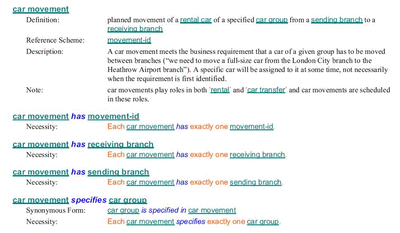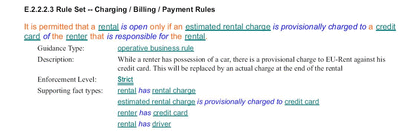For example, EU-Rent is a (fictitious) car rental company, used as a case study in the SBVR specification. The business requirements for EU-Rent include the following:
- EU-Rent operates in several countries; in each country it has local areas containing branches
- EU-Rent rents cars to customers from branches; one-way rentals are allowed
- Rentals may be booked in advance or ''walk-in''
- Cars are owned by local areas and stored at branches
- Each car is of a given model;car models are grouped into car groups; all cars in a car group have the same rental tariff
- Cars are serviced at 5.000 miles intervals
- EU-Rent notes ''bad experiences'' with drivers (police action, unpaid parking fines, cars damaged or not returned to EU-Rent branches, etc.) and may bar drivers who cause them.
This sample demonstrates how SBVR Structured English is used to specify a term ''car movement''. Specification provides a formal definition of the term, a reference scheme (how this term can be used in the documents), an informal description and a note. Specification also defines several fact types that relate the term ''car movement'' to other terms in the EU-Rent specification. Fact types are the basis for specifying business rules.
Necessity element defines a simple structural rule, which constraints the use of the fact type in the documents. The next section illustrates the sample specification using a UML-like notation.

The diagram illustrates part of the EU-Rent business vocabulary that includes the above sample. In UML terms, ''car movement'' is represented as a class in the middle of the diagram. The SBVR definition of the term ''car movement'' suggests several associations to a number of other classes.
Associations display role names of the association endpoints. A black triangle symbol indicates a named association that corresponds to a fact type, defined in SBVR. A white triangle indicated a class that is being specialized by one or more subclasses.
The next section shows a sample business rule specified in SBVR.
Sample business rule specified in SBVR Structured EnglishThis section shows a sample business rule specified in SBVR. References to business terms in the EU-Rent business vocabulary are displayed in sea-green color and underlined. Signifiers of the fact types from the EU-Rent business vocabulary are displayed in dark blue color and italicized. Keywords of the SBVR Structured English are displayed in orange color. Fact types define verb phrases; terms correspond to nouns.
Learn how SBVR defines precise meaning of statements expressed in Structured English language.
View the entire EU-Rent case study as it is described in the SBVR specification.


